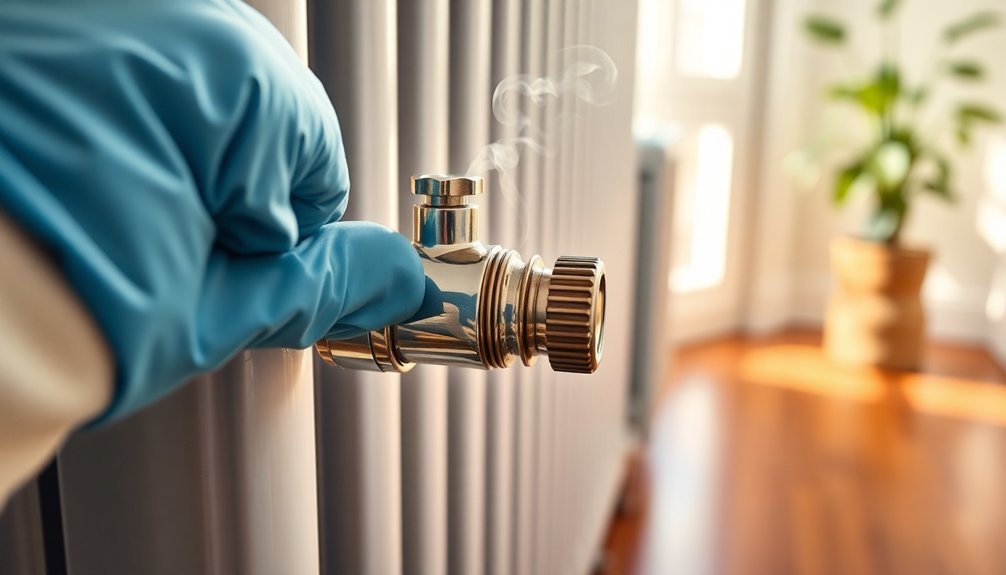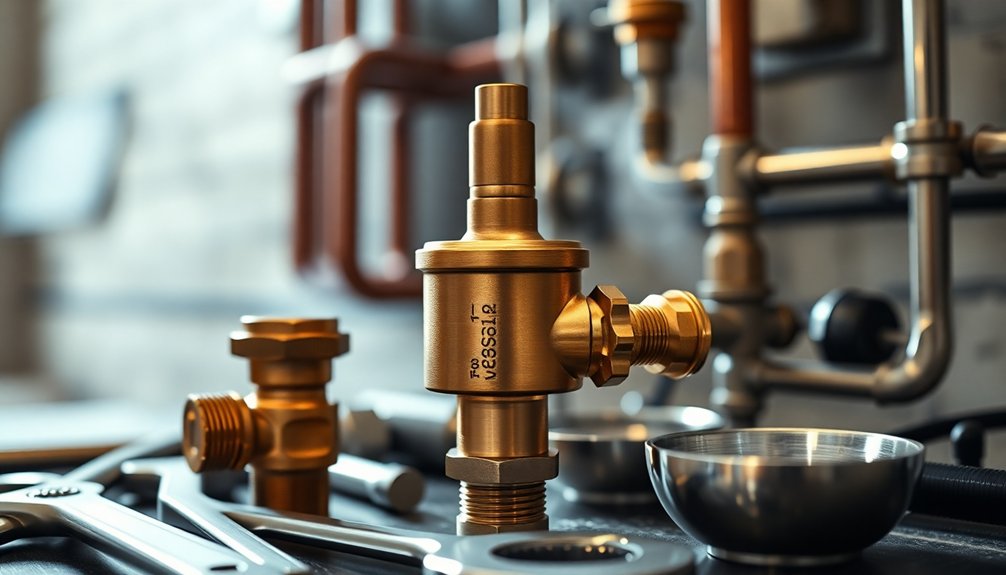To relieve pressure in your radiant heating system, first, make certain the boiler is completely cool. Shut off the water feed and check the pressure gauge. If the pressure exceeds 20 psi, bleed your radiators using a radiator key to release trapped air. Monitor the gauge during the process and inspect valves for leaks afterward. Keeping your pressure between 12-15 psi is ideal for efficiency. For more detailed steps and troubleshooting tips, keep exploring your options.
Understanding Boiler Pressure Dynamics
Understanding boiler pressure dynamics is vital for maintaining an efficient hydronic heating system, especially since low pressure can lead to inadequate heating while high pressure risks damaging the system.
Ideally, you should maintain boiler pressure between 12-15 psi for peak performance and effective heat distribution. Regularly monitor the pressure gauge, as low readings can indicate insufficient heating, and pressures above 30 psi may cause relief valves to leak.
Increasing the fill pressure can help eliminate air pockets, ensuring consistent water flow and reducing operational noise. Be aware that seasonal temperature fluctuations can affect boiler pressure, with colder conditions typically resulting in lower readings.
The expansion tank is essential in stabilizing these changes, keeping your system running smoothly. Utilizing expense tracking tools can also help manage the financial aspects of maintaining your heating system efficiently.
Signs That Indicate High Pressure
If you’re noticing pressure readings above the normal operating range of 12-21 psi in your radiant heating system, it’s essential to recognize the signs of high pressure.
One clear indicator is continuous dribbling or leaking from the pressure relief valve, which suggests excessive pressure may compromise your system’s integrity.
During heating cycles, if the pressure exceeds 20-21 psi, you could be facing issues like an expansion tank malfunction or too much water fill.
Unusual noises, such as banging or hissing, can also signal pressure-related problems due to air pockets or overpressure.
Regularly monitoring your system is vital; consistent readings above 30 psi can indicate potential mechanical damage that requires immediate attention. Additionally, clear payment terms for any repair services can help ensure timely and efficient resolutions to any issues that arise.
Preparing the System for Pressure Relief

Before you start relieving pressure, make sure the system is completely cool to prevent any risk of scalding.
Next, check the pressure relief valve‘s accessibility and functionality, as it’s essential for a safe operation.
This preparation sets the stage for effective pressure management in your radiant system. Additionally, understanding the importance of financial literacy can help you manage any associated costs effectively during this maintenance.
Ensure System Is Cold
To safely relieve pressure from your radiant heating system, ensuring it’s completely cold is vital.
First, power down the system and wait at least 8 hours for it to cool. Before proceeding, check the pressure gauge; it should indicate a pressure above the desired range of 10-20 psi. If the system is still hot, don’t attempt to relieve pressure, as this could lead to scalding.
Once you confirm the system is cold, connect a hose to the appropriate valve for draining water. Monitor the pressure gauge closely until it reaches the ideal level of 12-15 psi.
This process is essential for safe pressure relief and to maintain the integrity of your radiant heating system.
Check Pressure Relief Valve
Checking the pressure relief valve is a crucial step in preparing your radiant heating system for pressure relief.
Follow these essential steps to guarantee safety and effectiveness:
- Cool Down: Make sure the system is completely cool to avoid hot water discharge.
- Connect Hose: Attach a hose to the pressure relief valve for safe drainage during inspection.
- Monitor Pressure: Keep an eye on the pressure gauge while performing the check.
- Inspect Regularly: Look for leaks or continuous water discharge for over five minutes, which could signal a malfunction.
Always shut off the water feed to the boiler before checking the pressure relief valve.
This prevents overpressure conditions and keeps your system running smoothly.
Regular maintenance guarantees reliable operation and safety.
Steps to Reduce Boiler Pressure Safely
To reduce boiler pressure safely, start by shutting off the boiler and allowing it to cool down.
Next, carefully bleed the radiators using a radiator key to release any trapped air, which helps lower the system pressure.
Monitor the pressure gauge throughout this process to guarantee it stays within the recommended range of 12-15 psi. Additionally, utilizing expense management apps can streamline the process of tracking any costs associated with boiler maintenance.
Shut Off Boiler
Shutting off the boiler is a crucial first step in safely reducing boiler pressure.
Follow these essential steps to guarantee your heating system operates correctly:
- Turn off the boiler and let it cool down completely.
- Check that the filling loop valves are fully closed to prevent accidental pressure increases.
- Prepare to bleed the radiators by starting with the highest point in your system.
- Monitor the pressure gauge continuously while bleeding until you reach the desired pressure of 12-15 psi.
After achieving the correct pressure, inspect for any leaks and confirm that all valves are securely closed.
Bleed Radiators Carefully
Once the boiler is turned off and has cooled for at least 30 minutes, you can proceed to bleed the radiators.
First, confirm that the filling loop valves are fully closed to prevent additional water from entering the system.
Use a radiator key to carefully open the bleed valve at the top of each radiator until water starts to escape, allowing trapped air to release.
Monitor the pressure gauge closely as you bleed radiators carefully, one at a time.
After each radiator, check the pressure gauge and repeat the process until the boiler pressure stabilizes between 12-15 psi.
Once the desired pressure is achieved, verify all bleed valves are tightly closed to maintain system pressure and efficiency.
Monitoring Pressure Levels Post-Relief

After relieving pressure from your radiant heating system, it’s crucial to monitor the pressure gauge closely to confirm it stabilizes within the ideal range of 12-15 psi.
Keeping an eye on these levels can prevent costly repairs and guarantee your system operates efficiently. Here are some key actions to take:
- Regularly check pressure levels weekly during the heating season.
- Investigate any readings below 10 psi for potential leaks.
- Document any significant fluctuations to identify issues.
- Verify pressure doesn’t exceed 27-28 psi to avoid valve malfunctions.
Additionally, consider implementing payment alerts and reminders as a proactive measure to manage any associated costs effectively.
Troubleshooting Persistent Pressure Issues
Monitoring the pressure levels in your radiant heating system is just the first step in guaranteeing its efficient operation.
Regularly monitoring your radiant heating system’s pressure is essential for ensuring optimal performance and efficiency.
If you notice persistent pressure issues, start by checking the pressure gauge; it should remain between 12-15 psi. If it exceeds 30 psi, inspect for leaks and examine the pressure relief valve, as it may begin to drip at 27-28 psi.
Bleed radiators to release trapped air and verify the fill valve’s functionality. Additionally, confirm your expansion tank is working correctly, as failure can lead to pressure problems. Automated notifications can also help remind you of routine maintenance checks to prevent issues from arising.
If high pressure continues, shut off the water feed to the boiler, let the system cool, and drain water until you achieve the desired pressure level for effective pressure relief.
Maintaining Optimal Boiler Pressure for Efficiency

Maintaining ideal boiler pressure is essential for ensuring your radiant heating system operates efficiently and reliably. To achieve this, keep the following in mind:
- Ideal Pressure Range: Aim for 1 to 1.5 bar when heating is off, and 1.5 to 2 bar when on.
- Monitor Regularly: Consistently check boiler pressure to avoid exceeding 30 psi, which can cause system damage.
- Adjust Seasonally: Be prepared for pressure changes, particularly during heating when it may reach 20-21 psi.
- Routine Maintenance: Conduct regular checks to prevent pressure-related issues and enhance system longevity.
Additionally, regular reviews of your system’s performance can help identify any pressure fluctuations that may require adjustments.
Conclusion
As you stand by your boiler, the needle hovers dangerously close to the red zone, tension hanging in the air. You’ve followed the steps to relieve pressure, but what if it returns? The key lies in vigilance—monitoring the system and addressing issues promptly. Picture a well-functioning radiant system, humming quietly, delivering warmth without worry. By maintaining ideal pressure, you not only guarantee safety but enhance efficiency, inviting comfort into your home for years to come.



